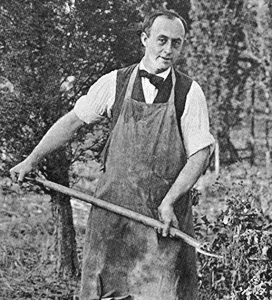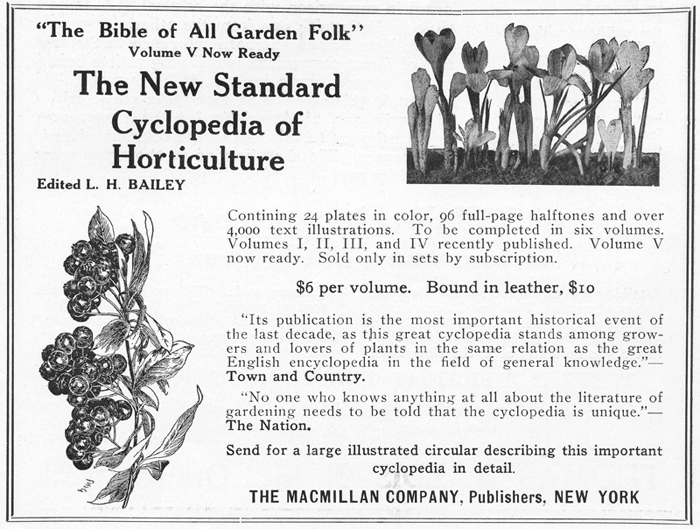| Join | Official Historian | City of Stamford | Blog | About Us | |
| Jewish Historical Society | Civil War Roundtable | Contact Us | |
|
|
|
|
Photo Archivist's Selection of the Month: June 2008
From Plates, Puddings and Pies to Plants
|
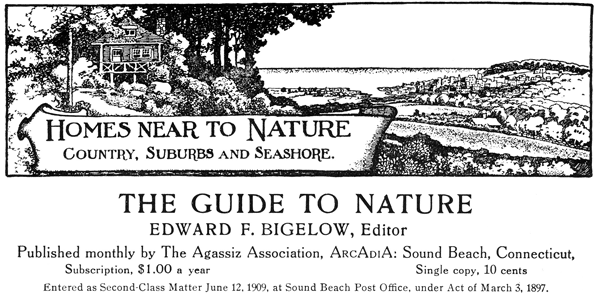 |
The Guide to Nature magazine issue of Volume 9, No. 7, December 1916, brings us a nice article under the heading HOMES NEAR TO NATURE. (Mr. Bigelow at his moralizing best.)
So here, just in time for gardeners, is
From Plates, Puddings and Pies to Plants.
By Edward F. Bigelow, ArcAdiA: Sound Beach, Connecticut.
Every one of the many frequenters of the Stamford Lunch in Stamford, Connecticut, has admired not only the excellent service but the decorations of the room. It needs only a glance to observe that the proprietor, Mr. Fred McDermant, is at heart a lover of nature. The entire upper part of the walls is decorated by that master artist and naturalist, Mr. R. Emmett Owen (see note), whom we have previously gladly commended in our pages. When first the restaurant was opened to the public, I inquired about the artist, sought his acquaintance and told the public of his wonderful talent. I knew, however, that more is involved than the talent of the artist. I knew that the proprietor must have desired to have such decorations, and that that desire must have emanated from his love of the great out of doors. Later I inquired of Mr. McDermant and found that his entire recreational resource and relief from the nerve racking details demanded by the managing of a popular restaurant are to get near to plants, to love them and care for them. Mr. McDermant has a beautiful home in the wilderness north of Stamford, surrounded on every hand by innumerable forms of the beautiful flowers that he loves. One sees in the daintily furnished veranda and in every room in the house evidence of care and good taste. The plant decorations, beautifully arranged by a man, an unmarried man, show none of the ordinary bachelor's awkward touch and the absence of feminine skill. The work has been done in a charming way by the bachelor, Mr. McDermant; he has done it for the love of it and done it skillfully.
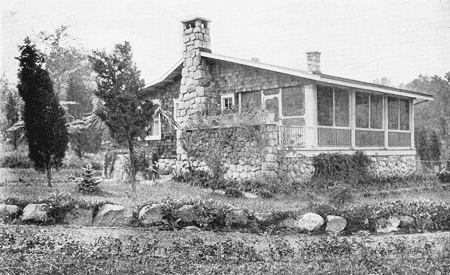
THE NATURE HOME OF FRED McDERMANT SURROUNDED
BY THOUSANDS OF PLANTS UNDER LOVING CARE.
His home is on a sunny hillside, where tall, sentinel cedars stand in the mellow sunshine like weird ghosts in the moonlight, with geraniums, gladioli and innumerable other plants covering the ground at their feet.
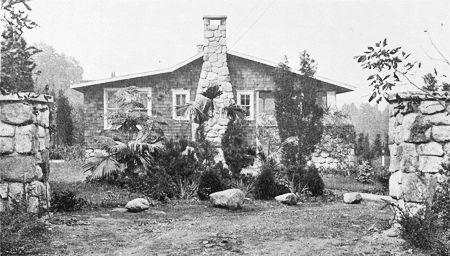
THE ATTRACTIVE VIEW FROM THE ROAD.
Perhaps in no one thing does Mr. McDermant show his love of the "truly rural," united with his affection for the plant world, better than in his novel decoration of buckwheat sowing. Almost apologetically he said, "Some persons would not have cared for it, but I wish you could have seen it when it was blooming in the fields. I sowed buckwheat because I love its flowers." There is "really truly rural" taste. When one turns to all the cultivated flowers, they seem to have engaged the artistic skill of an expert landscape architect, and the magnificent growth of the plants appears to show that they have been under the care of a skilled gardener. But Mr. McDermant is the only artist, the only gardener there. The arrangement, the massing of the colors, the relations of the plants to the house and the loving care given to them exhibit a combination of artistic taste and a landscape gardener's skill.

THE SPACIOUS VERANDA FOR OUTDOOR LIVING.
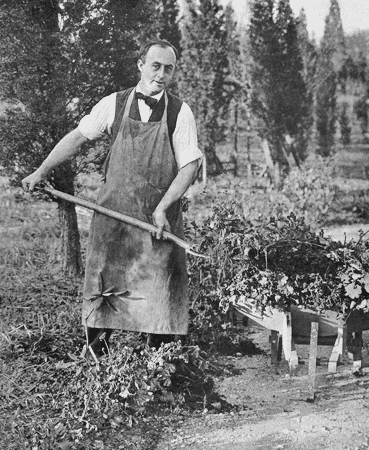 REAL JOY IN TAKING UP HUNDREDS OF GERANIUMS. |
Why has THE GUIDE TO NATURE selected Mr. McDermant and his premises for exploiting before its readers? Because we have discovered that here is a man who although he is conducting a business that requires the closest of attention, unlike other business men, does not tell us, "I have no time for such things," but he proves by the aspect of his home and grounds that he has plenty of time for such things. The exacting care of the restaurant is practically the same as the exacting care of these premises, yet he has proved that work may be rest. A change of occupation is the best vacation. What Mr. McDermant has done others may do. We publish this article and the illustrations because we believe that his example is a good example. THE GUIDE TO NATURE has been accused of exploiting only magnificent estates. We have been accused of tantalizing our readers when we show what can be done by millions. I remember a few years ago that we had an extended article descriptive of a magnificent estate on which was an artificial lake made at an expense of several thousands of dollars, and on that lake many kinds of waterfowl. In regard to it a reader said: "That is not guidance to nature. That is exhibiting to us what to us is unattainable." I retorted, "Do you really want a little bit of water and are you interested in waterfowl?' "Yes, certainly," he said, "I would have them if I were rich.” “Would you really?" I still insisted. "Then in that little pool in your back yard, why do you not keep at least a duck or a goose?" "That would not be a lake.” “It would be water and a waterfowl. You are not admiring nature so much as you are admiring this lake and these waterfowl as you are admiring the millions that made them possible." If the reader says that we are tantalizing him when we show him that beautiful lawn with its shrubbery and its magnificent trees, the question may well be asked, Are you interested in the things or in the money that makes them possible? If you love plants you can get at least one shrub for your front yard, or one plant in a pot of earth. There is the lesson that Mr. McDermant is teaching. He shows us that real love of plants, even when one has not hundreds of acres for exploiting them, may be a resource and recreation in life. When American people with their clamorings for eight hours of sleep, eight hours of work and eight hours of rest shall have learned how to use to better advantage those eight hours of rest in the simple resources of nature, then we may be ready for even shorter hours of work and longer hours of recreation. I firmly believe that the big problem before the American people is not shorter hours of labor, but how to make the eight hours of recreation more helpful and beneficial. Having a lake and waterfowl is one method, having gladioli, geraniums and buckwheat, if you please, is another. There are still others as we from time to time shall continue to prove. But the lesson that we learn this month from Mr. McDermant is that plants not for the dollars and cents that may be in them as a resource in life are really worth while. Here is a good point in guidance to nature and here is the reason for this article.
It will be of interest to our readers to know the arrangement and the extent of plants, shrubs and bulbs in which Mr. McDermant has taken especial interest for the summer of 1916.
East Wall: Gladioli, Princeps, 1500; Phlox, Drummondi, 300; Hemlocks, 100.
South Wall: Petunia, Rosy morn, 2000; Gladoli, Princeps, 1500; Spirea, Van Houttei, 40; German Iris, 1500.
West Wall: Rosa Rugosa, 40, Hybrids, 100; German Iris, 1500.
Drive Border: Paeonies, Grandiflora Rosea, 100.
Circular Beds: Cannas, King Humbert 200; Salvia, Splendens, 300; Geranium, Grant, 200; Tuberous Begonia, 250.
Old-fashioned Garden: Perennials assorted, Conifers in groups.
This ad was included
The standard cyclopedia of horticulture; a discussion, for the amateur, and the professional and commercial grower, of the kinds, characteristics and methods of cultivation of the species of plants grown in the regions of the United States and Canada for ornament, for fancy, for fruit and for vegetables; with keys to the natural families and genera, descriptions of the horticultural capabilities of the states and provinces and dependent islands, and sketches of eminent horticulturists (Volume 3) (1919 [c1914])
Online:
Internet Archive: The Standard Cyclopedia of Horticulture By Liberty Hyde Bailey
Lots of illustrations, can be read online as Flip Book, or downloaded as PDF file.
Requires free sign-up for multiple viewing.Liberty Hyde Bailey (Wikipedia, handle with care)
Editor's Note:
The City directories show that in 1916 Mr. McDermant lived above his restaurant "Stamford Lunch" on 276 Main Street. By 1919/1920 he had moved to "Turn-of-River" as the area was called – presumably into the above house. This is where the Rippowam River turns sharply just east of High Ridge Rd., above the Parkway.
As to Mr. McDermant's attire in the photo, I wonder whether it was common to wear shirt and tie when gardening at the time, or whether that was for the photographic session only.
Robert Emmett Owen (1878-1957). If you search Google, you will find a number of images of his art in the various auction houses.
Other Photo Archivist Selections of the Month
Photo Collection Information
Photos © Stamford Historical Society
